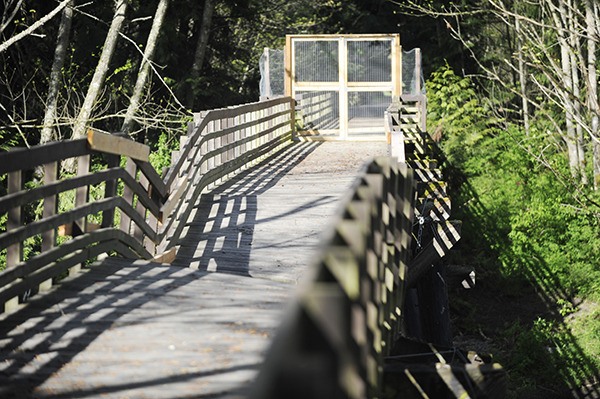A long-term design and permanent reconstruction remain a thing of the future for the damaged trestle at Railroad Bridge Park, but the possibility of a more immediate repair by summer still is on the table.
Jamestown S’Klallam Tribal officials are “considering” using insurance proceeds to potentially open through traffic across the Dungeness River via the bridge and adjoining trestle by summer, Annette Nesse, the tribe’s chief operating officer, said.
Although Nesse still is waiting to determine the exact level of coverage and the deductible amount, the tribe’s property insurance will cover the cost to repair the structure to its previous “as is condition,” she said. However, instead of repairing the damaged structure with outdated materials such as the creosote pilings, more modern material such as steel likely would be used.
Possible limitations to fixing trestle by summer include permitting, as some work within the water is necessary, and scheduling around periods of increased fish activity, Nesse explained.
Despite the possible time and permit constraints, if tribe officials are able to direct the insurance proceeds toward a more timely fix, Nesse said it would allow them the time needed to further explore a more permanent and modern design.
“The old design lasted 100 years and we want another design to last at least 100 years or more, but we don’t think the current design is the best approach,” she said.
Since the flood conditions in early February and the damage to the trestle, it has been closed to through traffic causing Olympic Discovery Trail users to use alternative routes. Because of this, Powell Jones, executive director of the Dungeness River Audubon Center, said he’s noticed a “visible drop-off in visitors” to the park, which is operated by the Dungeness Audubon River Center and its partners, the Jamestown S’Klallam Tribe, Olympic Peninsula Audubon Society and Audubon Washington.
Although the park is open and free to the public, the reduction in usage can impact it because donations and new members often are gained by visitors coming through the door and simply exposure to the park, Jones said.
“Obviously the damaged trestle makes an impact. Without the bridge there just isn’t as much traffic,” he said. “The important thing is to get the community resource back.”
Given the dynamic nature of a river system such as that of the Dungeness River’s, Nesse explained instead of just a trail repair project, a new trestle design also could be geared toward enhancing river habitat by better suiting the river environment.
Already, Nesse anticipates a “positive response” from the Salmon Recovery Funding Board in reaction to a more environment-friendly river crossing. To engineer and update the trestle, Nesse estimates the long-term design to cost about $1.8 million.
Managed by the Washington State Recreation and Conservation Office, the Salmon Recovery Funding Board created in 1999 by the state Legislature provides grants to protect or restore salmon habitat and assist related activities.
Nesse hopes to have more details from the tribe’s insurance company within the next couple of weeks and then will be able to move forward with the project’s next steps.
“We’re really hoping to get the river crossing open this summer,” she said.
Reach Alana Linderoth at alinderoth@sequimgazette.com.


